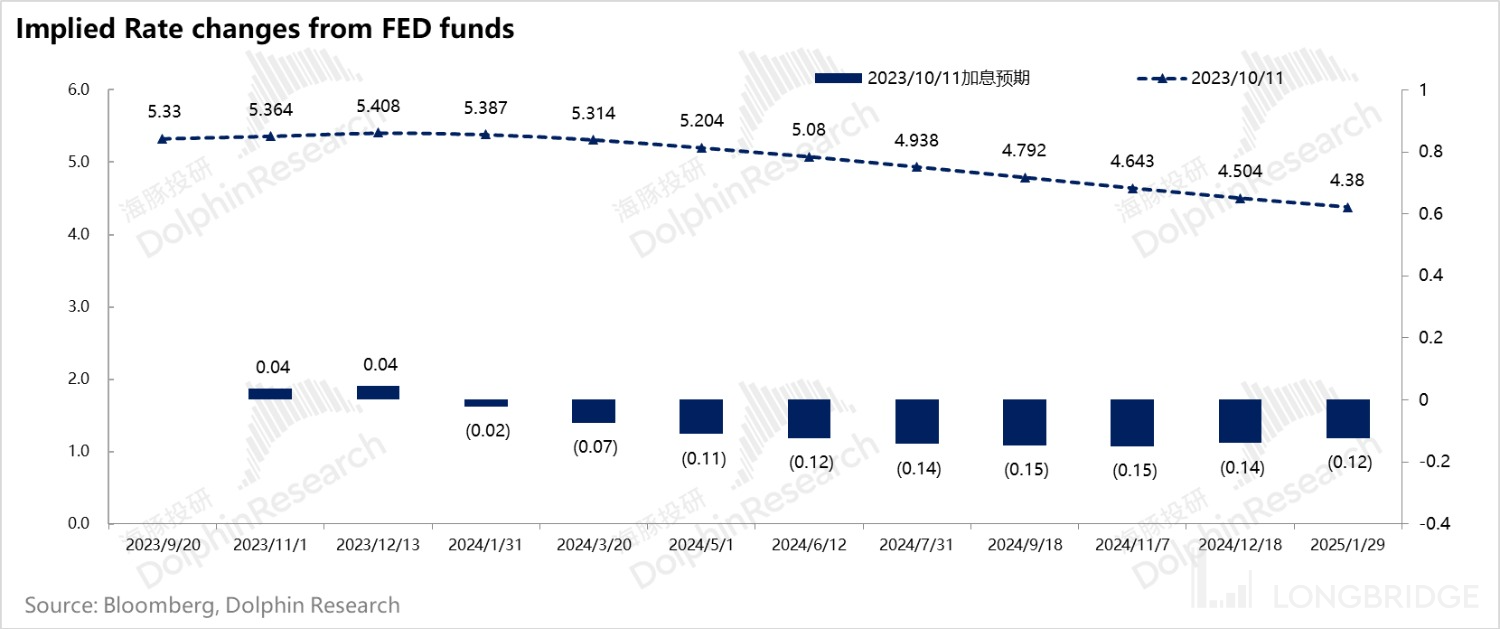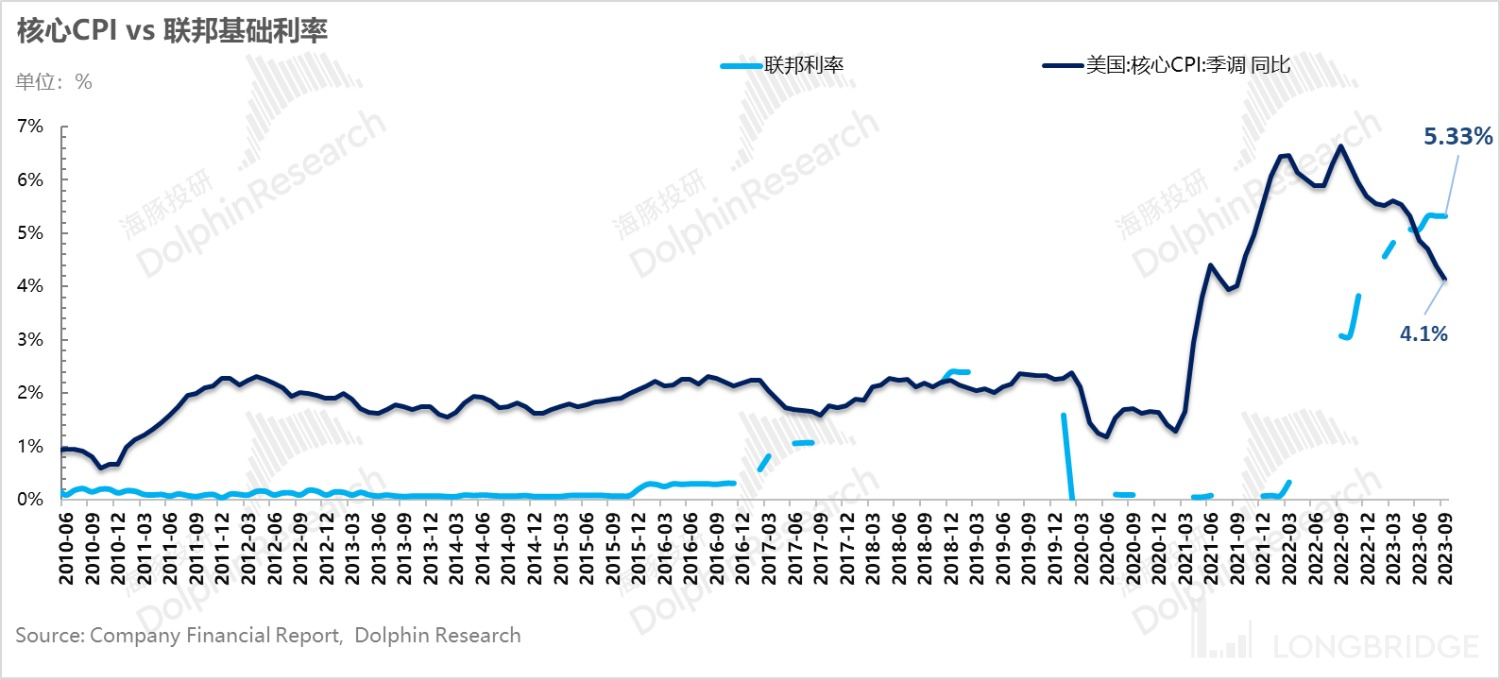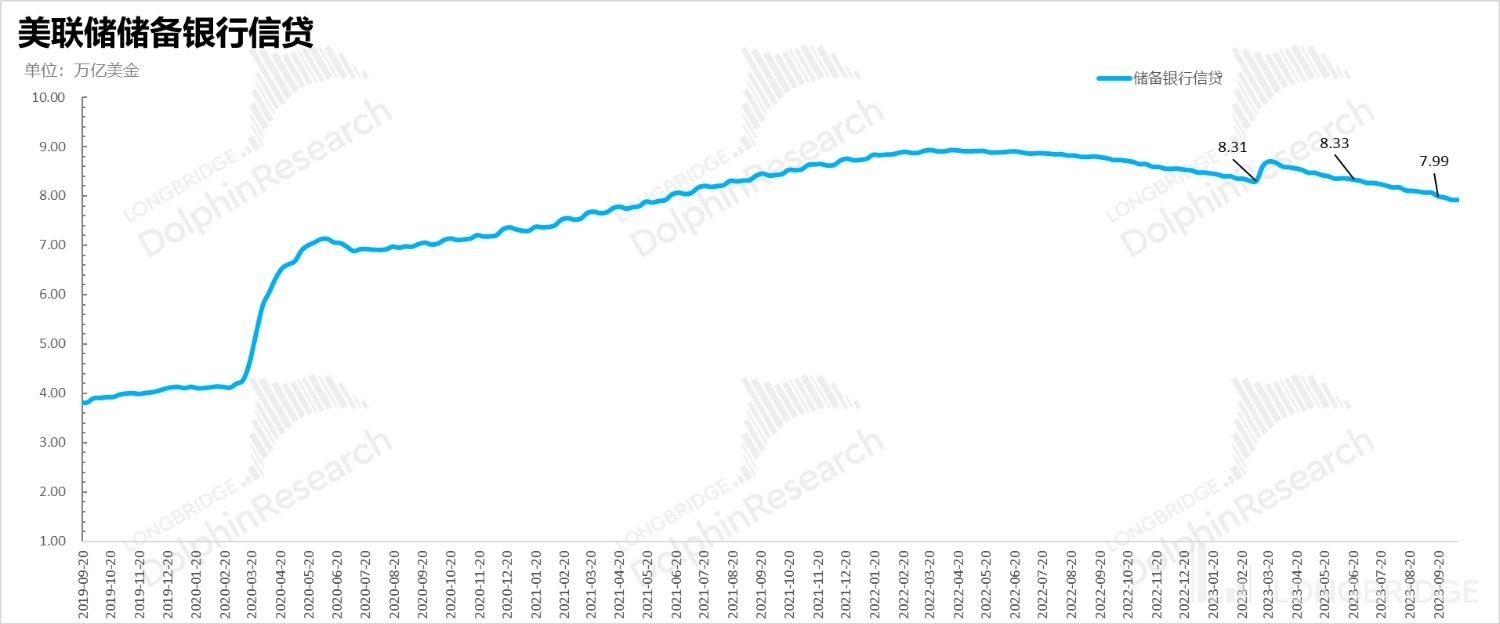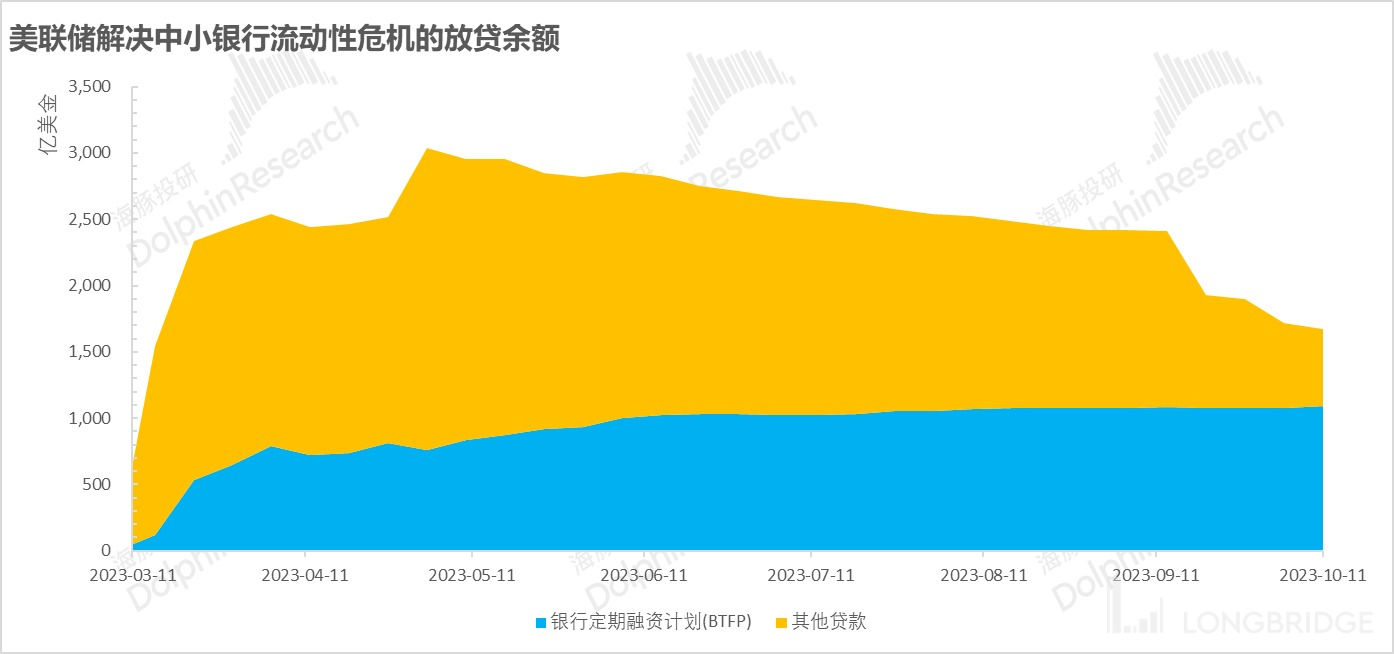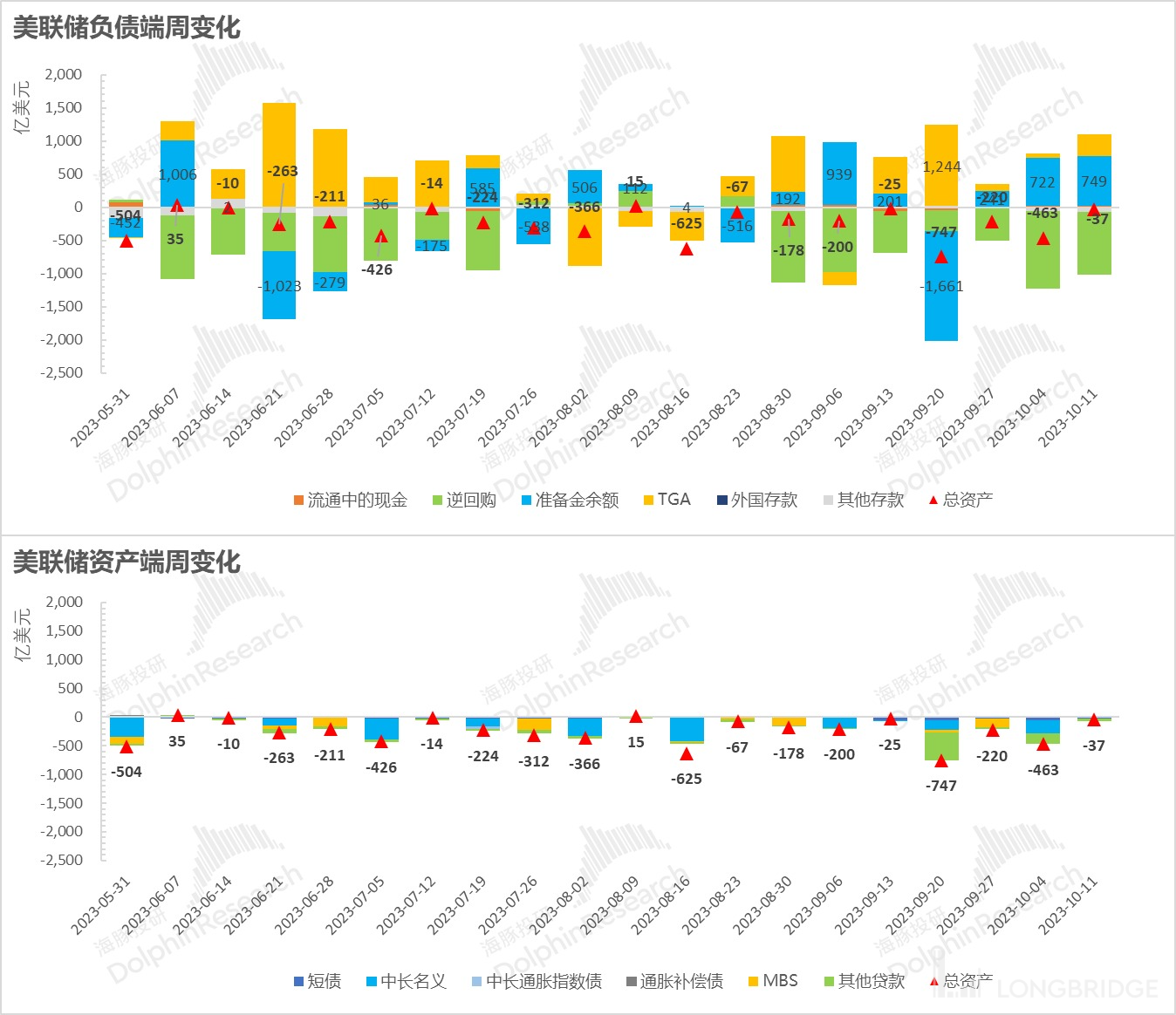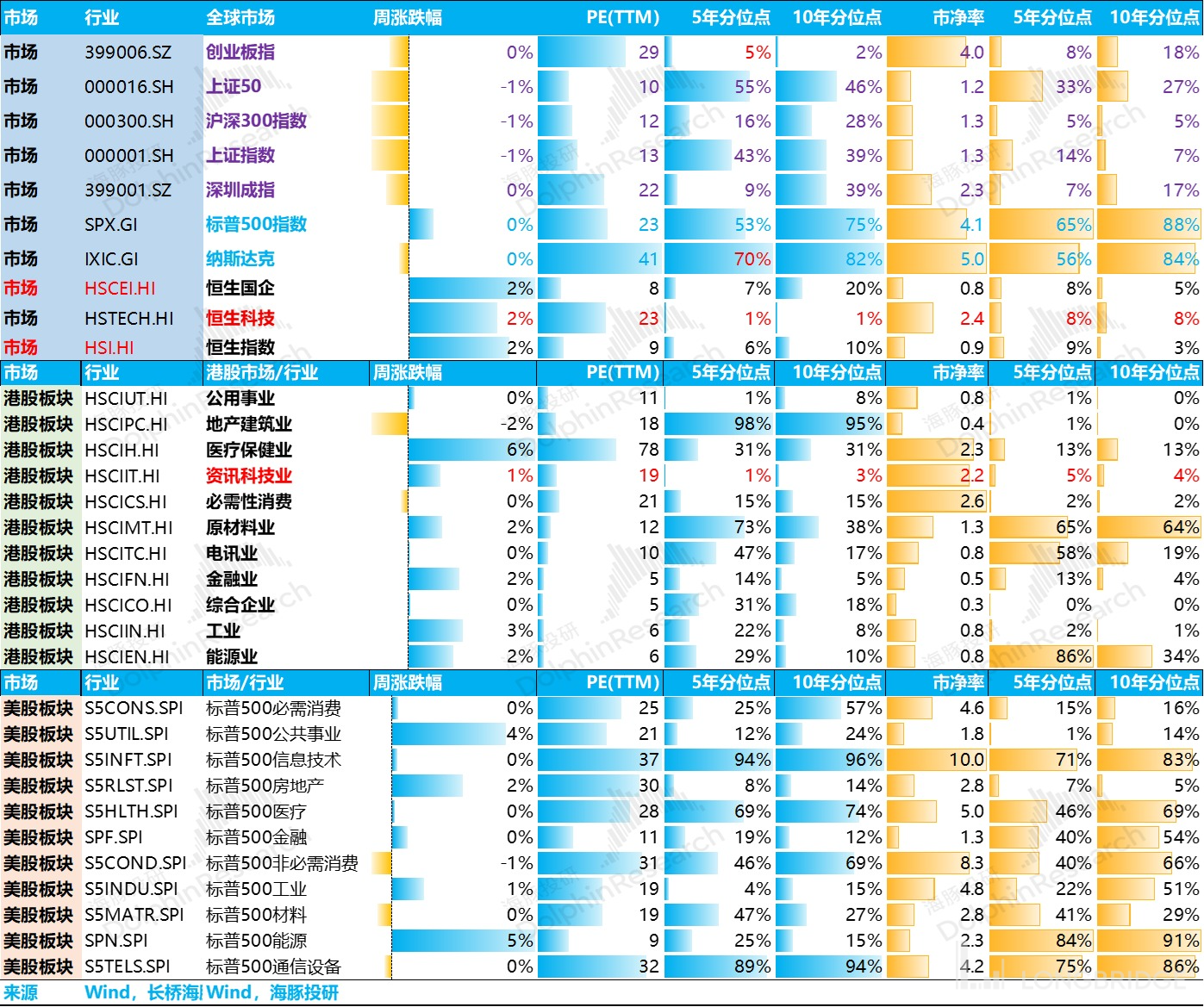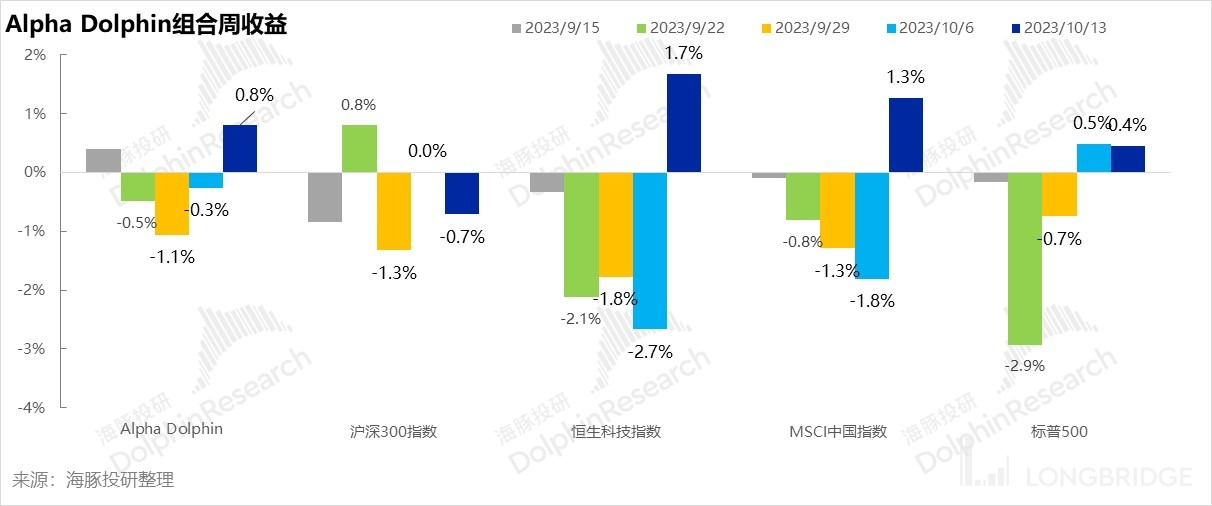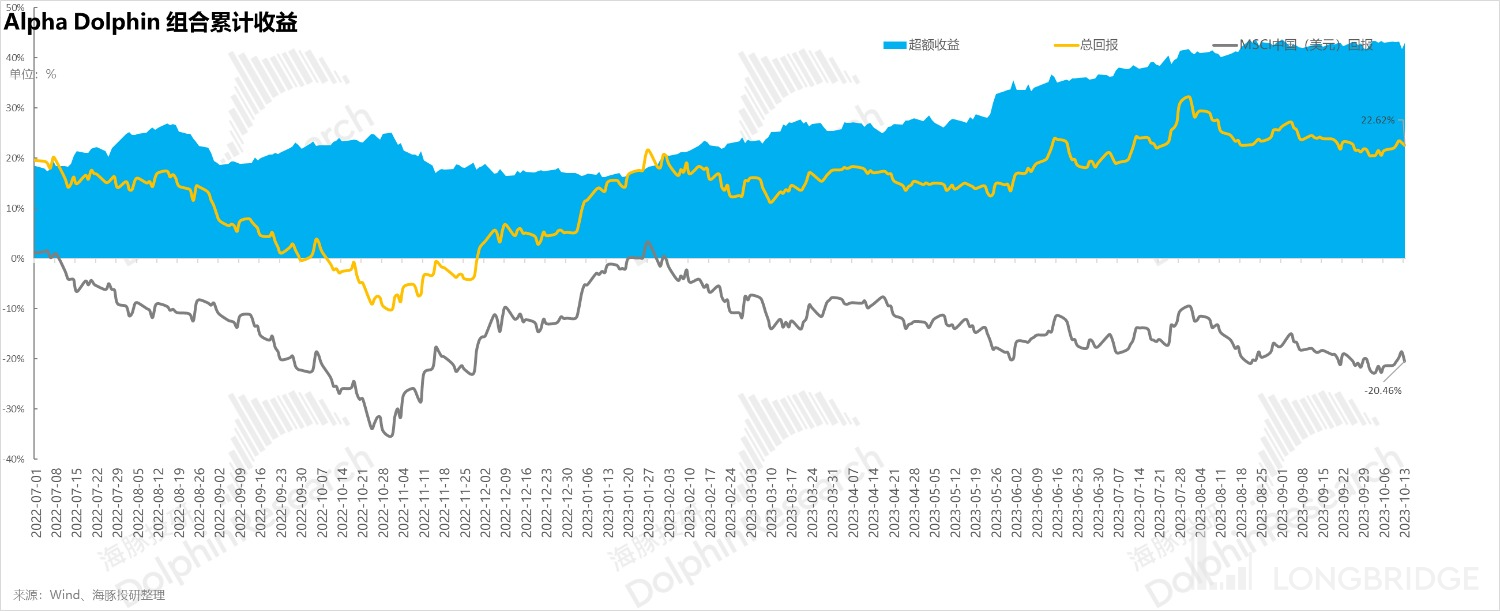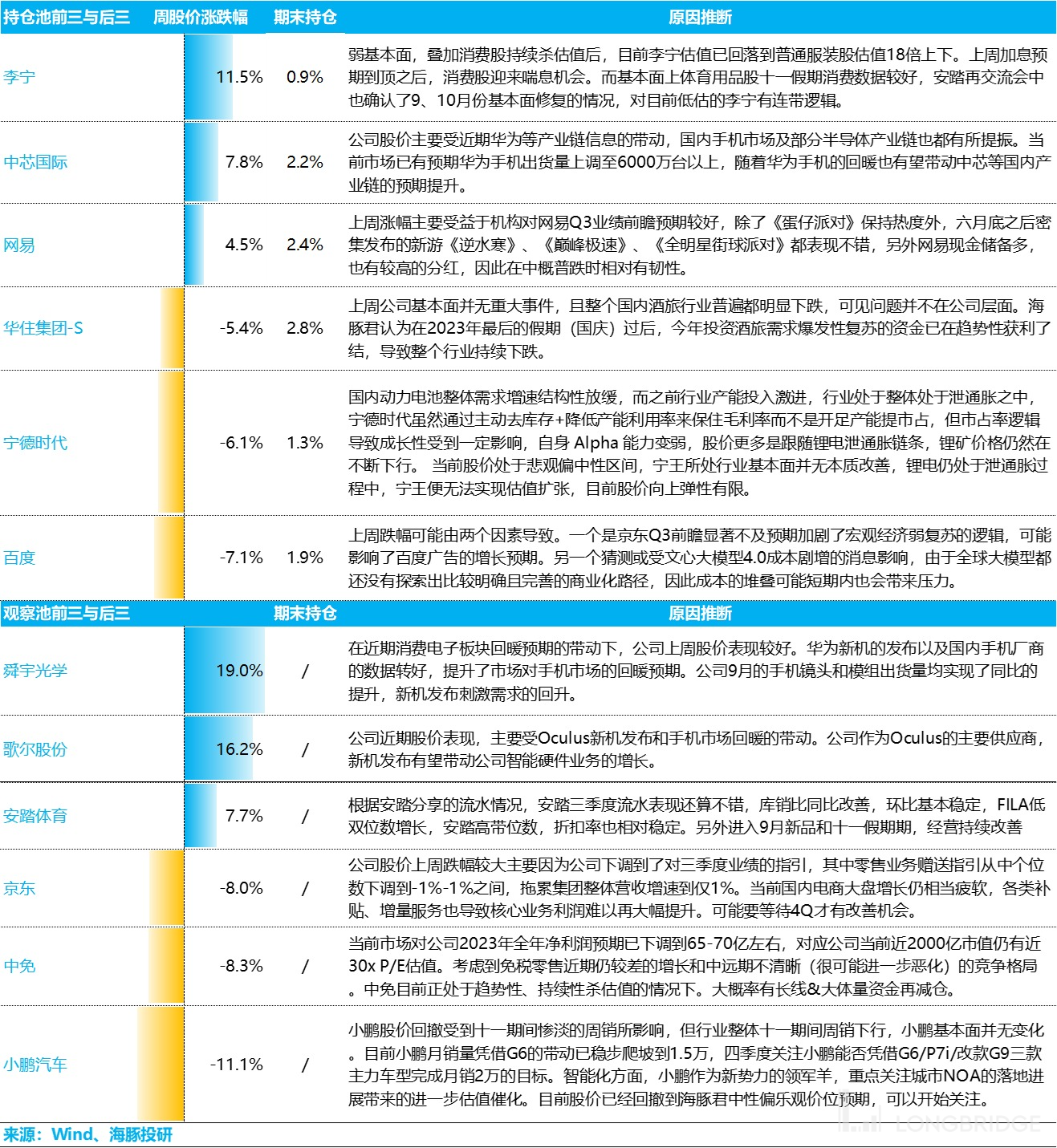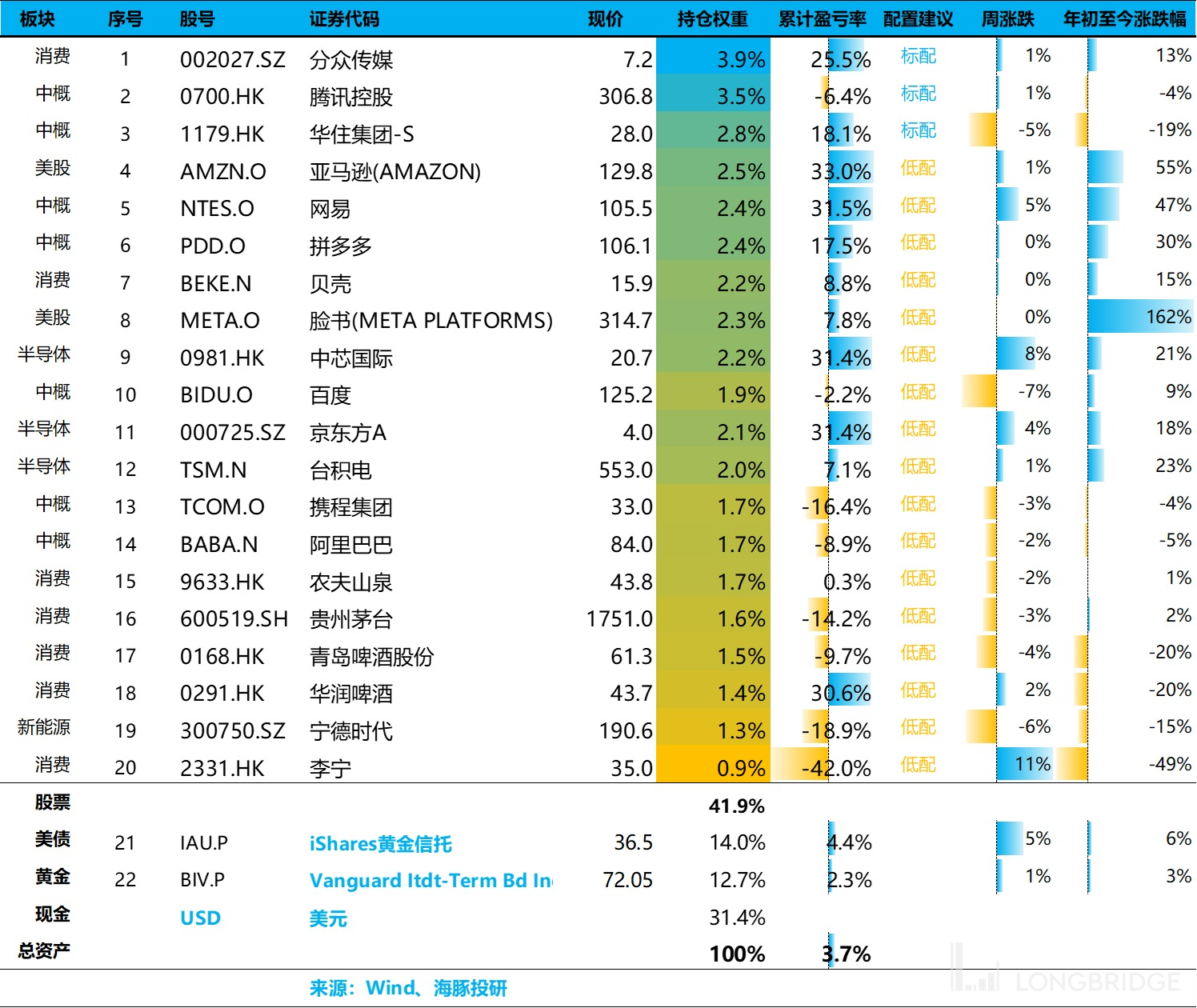JD.com causing Chinese concept stocks to collapse ? Problems are US economy's "three highs" Syndrome
Hello everyone, here is Dolphin Research's summary of the core information on this week's portfolio strategy:
1)US' September CPI data may seem higher than expected, but the unexpected rise in housing costs, in Dolphin Research's view, does not affect the path of the US interest rate hike. However, since core prices did not fall as expected, it also did not bring a timing for when the possibility of a rate cut might occur, which cannot "treat" the "high interest rates, high long-term bond yields, and high US dollar" symptoms caused by the current liquidity tightening.
2)The real key marginal change in the second half of the year is liquidity tightening. Unlike the first half of the year, where the US Federal Reserve sold off government bonds and then released short-term loan tools to banks, as well as the Treasury Department consuming the TGA account to inject high liquidity into the real economy, the situation in the second half of the year is completely different. The Fed's quantitative tightening is real, and the TGA account is also being rebuilt.
3)The progress of disinflation is not as smooth as expected by the market, coupled with the real drainage of liquidity, these two major factors resonate, corresponding to what Dolphin Research calls the "chicken ribs" opportunity in the US stock market in the second half of this year. Especially when it comes to the current valuation percentile of US stocks and AI-driven Nasdaq, the attractiveness is currently scarce.
4) From the perspective of valuation and cost-effectiveness, Hong Kong stocks are almost the highest, but it should be noted that the impact of the US dollar's interest rate hike on valuation, coupled with the impact of quantitative tightening on liquidity in the second half of the year, is actually more severe for the US dollar peripheral market than the domestic US dollar market.
For Hong Kong stocks, attention should still be paid to the gradual return of liquidity and the bottoming out and recovery of the domestic economic fundamentals. In the data released in September, both domestic PMI and social financing have started to bottom out, but the rebound can only be described as "weak". This week, there are still data such as September social retail sales, CPI, and fixed asset investment to be released, and we also need to see the strength of the recovery in these data.
Here are the details:
The Fed's interest rate hike this year has been the main theme affecting global capital markets. Based on the latest market expectations, the rate hike should have already come to an end. Perhaps the Fed is reluctant to admit it, but in fact, both from the burden of interest payments on the government's finances and the current inflation trend, the probability of a rate hike this year has become smaller and smaller.
And the market does expect this. You should know that in the first half of this year, every time the market expected the "rate hike to peak," the peripheral US dollar market would experience short-term valuation repairs.

However, in the second half of this year, after Fed officials released dovish signals that the rate hike may have peaked, the market rebounded significantly weak. The so-called rebound was basically short-lived, and participating in such opportunities is not worth the effort, which is what Dolphin Research calls "chicken ribs".
The core contradiction behind the chicken ribs is that although the market's rate hike expectations have peaked, the expectations of a rate cut have not yet arrived, resulting in a lack of effective hedging during the substantial quantitative tightening process by the Fed in the second half of the year.
1. The current round of interest rate hikes is almost over, but the timing of interest rate cuts is uncertain.
Based on the current interest rate comparison, the Federal Reserve's policy rate of 5.33% is already significantly higher than the year-on-year growth of core CPI at 4.1%. In other words, as long as CPI/core CPI does not rise again on a month-on-month basis, the current policy rate is already in line with the current inflation trend.
Although the September CPI data did not fall as smoothly as expected, it did not affect the judgment that interest rate hikes have reached their peak. Firstly, due to the continued rise in oil prices in September, the overall month-on-month CPI did not return to the range of 0.1%-0.2% before the increase in oil prices in July, but remained at 0.4%. Since oil prices have started to decline, the fluctuation of oil prices is not the core issue.
The key is that the rate of decline in core CPI this month is lower than expected, and even higher than when core inflation rose due to the increase in oil prices last month, reaching 0.32% on a month-on-month basis. Looking at core inflation excluding housing inflation, it is actually in a declining state, with a month-on-month increase of only 0.1% in September. Since the real estate sales (including second-hand houses and new houses) are still relatively sluggish, the increase in housing costs this time is more of an anomaly rather than a sustained trend.
In terms of another indicator to watch for inflation expectations, the month-on-month wage cost in September is still slowing down, at only 0.21%. Overall, it can be seen that the progress of disinflation
is still in a deterministic state before the escalation of the Israeli-Palestinian conflict affects oil prices.
In summary, although the CPI data for September did not deviate from the path of core price disinflation, the failure of core prices to fall as expected has not provided a timing for possible interest rate cuts, and it cannot "treat" the "high interest rates, high long-term bond yields, and high US dollar" symptoms caused by the current liquidity tightening.
2. Liquidity tightening in the second half of the year after easing in the first half.
In this situation, the liquidity tightening of the US dollar lacks effective hedging. We know that in the first half of the year, the Federal Reserve only controlled prices (interest rates) in terms of monetary policy quantity and price, and the quantity of money was actually loose rather than tight.
However, quantitative tightening in the second half of the year is real:
In the first half of this year, although the Federal Reserve also sold Treasury bonds, after hedging with the rescue tools for small and medium-sized bank crises, the Federal Reserve's total assets in July did not change much from March, and even expanded in the meantime.

However, in the second half of this year, in addition to the reduction of assets due to the sale of US Treasury bonds by the Federal Reserve, there is also the recovery of liquidity crisis funds from small and medium-sized banks in the first half of the year. This means that the market will face dual liquidity recovery pressure in the second half of the year, and this pressure may continue until the first half of next year.
Among the types of loans generated by this crisis, loans related to bank deposit insurance have been rapidly reduced, currently shrinking to $60 billion, but there is also a $100 billion bank term financing plan (BTFP). According to the original plan, BTFP loans should have matured by mid-March 2024.

According to the latest situation as of October 11th, although the asset side of the Federal Reserve has eased its selling pressure, the Federal Reserve is still using reverse repurchase agreements to hedge the liquidity pressure caused by the US Treasury's borrowing, as the TGA account is still being rebuilt.

The combination of the above (1, 2) basically means that even if the US stock market rebounds in the second half of the year, as Dolphin Research has been saying recently, this rebound is lackluster. Especially when it comes to the valuation percentile of the current US stock market and the AI-driven Nasdaq, there is currently little attractiveness.

From the perspective of valuation and cost-effectiveness, Hong Kong stocks are almost the highest, but it should be noted that the impact of the US dollar's interest rate hike on valuation, coupled with the quantitative tightening in the second half of the year, still need to pay attention to the gradual peak of liquidity inflows, and the bottoming out and recovery of the domestic economic fundamentals.
Currently, China's PMI and social financing have both bottomed out, but the rebound can only be described as "weak". The rebound in PMI is very small, and although the total amount of social financing in September is still acceptable, the problem lies in the structure. Apart from the rebound in medium and long-term loans for residents due to relaxed housing purchase conditions and the continuous efforts in government bonds, the main problem is that financing activities related to enterprises are relatively sluggish.
This week, there are still data on September social retail sales, CPI, fixed asset investment, etc. in China, and we need to see if these data can rebound.
3. Portfolio Returns
On October 13th, the Alpha Dolphin portfolio did not make any adjustments. The virtual portfolio returns of Dolphin Research increased by 0.8%, weaker than Hang Seng Tech (1.7%) and MSCI China (1.3%), but stronger than S&P 500 (0.4%) and Shanghai and Shenzhen 300 (-0.7%).

Since the start of the self-combination test until last weekend, the portfolio has achieved an absolute return of 23%, with an excess return of 43% compared to MSCI China. From the perspective of net asset value, Dolphin Research's initial virtual assets were $100 million, and it is currently $124 million.

4. Contribution of individual stocks' gains and losses
Last week, overall, interest rate hikes reached their peak, and there was some relief in the valuation pressure on US stock assets, while Chinese concept stocks rebounded more strongly.
Regarding the specific companies that have experienced significant gains or losses, Dolphin Research has summarized the reasons as follows:

5. Portfolio asset distribution
In the past two weeks, the Alpha Dolphin portfolio has not made any adjustments and has allocated 20 stocks, including 3 stocks with standard ratings and 17 stocks with lower ratings. The remaining assets are in gold, US bonds, and US dollars.
As of last weekend, the asset allocation and equity asset holding weights of Alpha Dolphin are as follows:


6. Key events this week
This week marks the start of the US earnings season, with Tesla taking the lead among major companies. However, it is estimated that the performance will be average. In addition, in the semiconductor sector, it is worth paying attention to the possibility of the current semiconductor cycle entering an upward phase.
Apart from these, Dolphin Research will also track and analyze events such as Zero Run tonight and Hikvision over the weekend. Please stay tuned.

Risk disclosure and statement for this article: Dolphin Research Disclaimer and General Disclosure
For recent weekly reports from Dolphin Research, please refer to:
"Technology Makes a Comeback: Can US Stocks Replicate the Brilliance of the First Half of the Year?" 100,000-word article: The Federal Reserve's "iron fist" continuous hammering, the US stock market can't hold on anymore!
Don't panic, the bottom of Chinese concept stocks may have already arrived.
As the US unemployment rate rises, there is hope for Chinese concept stocks.
Inflation vs. skimming, the second half of the year won't be easy.
Is the US government spending money like water? The backlash has come.
The "brotherhood" behind NVIDIA and Tesla, can it still exist in the second half of the year?
Is there still redemption for the Hong Kong stock market?
Fitch is just a "paper tiger", Chinese concept stocks still have hope. "After the violent rebound, should we stay or leave the Hong Kong stock market?"
"Has the US interest rate hike reached its peak? Is there hope for the Hong Kong stock market?"
"Reality strikes, how far can the rebound of Chinese concept stocks go?"
"Looking ahead, will the US interest rate hike exacerbate stagflation?"
"Decoding the mystery of low savings in the US, is it sustainable?"
"US housing market: the original sin of subprime mortgages, why is it resilient this time?"
"Unraveling the recession: where did it go after being mentioned, and can it come back?"
"Can a short essay influence the market? Extreme optimism after extreme pessimism is the key."
"Is the US stock market party never-ending? Economic schizophrenia, beware of excessive joy leading to sorrow." 《Hell vs Carnival: What are the US and Hong Kong stock markets trading?》
《US stocks pull valuation, Hong Kong stocks kill Beta? Don't despair, reversal is imminent》
《 Put high interest rates in another bank? The chances of a soft landing are even greater》
《 ChatGPT vs Performance Release, Can Giants Support the US Stock Market?》
《 Is the "US recession, China recovery" plan going down the drain?》
《 The direction of the US recession is set, it's just a minor setback, a major setback is harmful》
《 US service consumption collapses, US stocks celebrate?》
《Fed rate cut: Just waiting for a moment for the US version of Yu'EBao to strike?》
《US stocks are going to decline, interest rates are going to be cut? Anyway, trading has already taken the lead》 app_id=longbridge&channel=t4444430&invite-code=032064)
《 Silicon Valley Bank Squeeze Crisis: will the US recession run to the scene?》
《 After giving up trading in US stocks, the world can finally breathe a sigh of relief》
《Inflation confirms its existence: turning around is an opportunity》
《 Pushing inflation aside, signals in Alibaba and Baidu are more important》
《 Hong Kong and the US are both weak, but will the wolves come again?》
《High-frequency macro as a marionette, the US stock market is a puppet market》
《 A bullish single candlestick changes beliefs, Tesla leads US stocks to come back?》
《 How far away is the turbulent and changing situation of the US stock market》
《 US stocks did not have a red New Year, but strong performance is in sight?》
《 Digging up the root of the sluggishness of the US stock market》《CPI Has Fallen, Why Is the Federal Reserve Still So Hawkish?》
《Is It Really That Easy to Eliminate Service Inflation? Beware of Market Overreaction》
《Has Hong Kong Stocks Finally Found Its "Strong Backbone"? Can the Independent Trend Continue?》
《Darkness Before Dawn: Is the Key to Success Mindset During Dark Times or Dawn?》
《 The Reality of US Stocks "Fighting Back," Can Emerging Markets Still Bounce for a While?》
《Global Valuation Recovery, But There Is Still a Test of Performance》
《China's Violent Asset Boom, How Come It's a World of Difference from the US?》
《Behind the Expectation of Policy Shift: Is Unreliable "Strong Dollar Fund" GDP Growth?》
《Slowing Interest Rate Hike? The Dream of the US Fed is Shattered Again》
《 Re-Understanding a "Iron-blooded" Federal Reserve》"A Sad Second Quarter: The 'Eagle's Cry' Rings Loudly, Collective Crossing Difficulties"
"Falling to Doubt Life, Is There Still Hope for Desperation?"
"Violent Inflation Hammered by the Fed, Domestic Consumption Opportunities Arise?"
"Global Markets Plunge Again, Labor Shortage in the United States is the Root Cause"
"The Fed Becomes the Number One Bear, Global Markets Collapse"
"The United States Shifts Left, China Shifts Right, Cost-effectiveness of US Assets Returns"
"Layoffs are Too Slow, More Troubles Ahead for the United States"
"US Stocks Celebrate 'Funeral': Recession is Good, Strongest Rate Hike is Bearish Exhausted"
"Entering the Second Half of Rate Hikes, 'Earnings Thunder' Begins"
"The Epidemic Strikes Back, US Recession, and Changing Tides of Capital" 《China's Current Assets: "No News is Good News" in US Stocks》
《Is Growth Already a Carnival, or is the US Definitely in Decline?》
《Is the US in Decline or Stagnation in 2023?》
《US Oil Inflation, Can China's New Energy Vehicles Grow Strong?》
《As the Fed Speeds Up Interest Rate Hikes, Opportunities in Chinese Assets Arise》
《US Stock Inflation is Exploding Again, How Far Can the Rebound Go?》
《The Most Down-to-Earth, Longbridge Dolphin Investment Portfolio is Launched》




